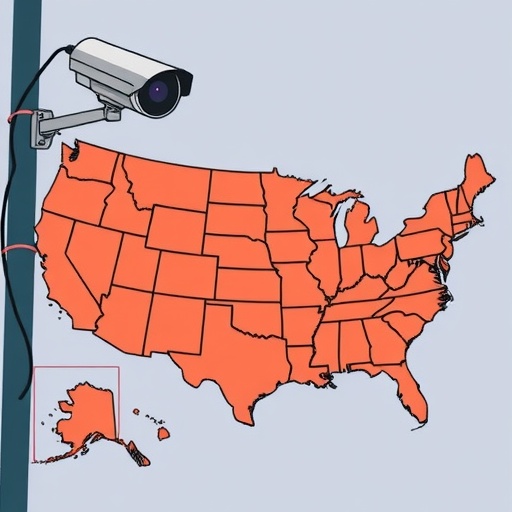
In the evolving landscape of urban monitoring, surveillance cameras have become an omnipresent feature defining contemporary city life. These sophisticated devices, embedded into the fabric of public infrastructure, serve multiple purposes—from deterring crime to enforcing social norms. However, the strategic placement of these cameras also reflects deeper societal dynamics, particularly relating to race and power within urban neighborhoods. A groundbreaking study published in Nature Cities (2025) sheds new light on how surveillance camera distribution intricately relates to neighborhood racial composition across ten densely populated US cities, challenging long-held assumptions and unveiling surprising insights into spatial inequality.
Traditionally, social science theories posited that predominantly Black neighborhoods are disproportionately surveilled, reflecting broader systemic inequalities and the legacy of racialized policing. This assumption presumes that increased surveillance directly corresponds to marginalized communities, effectively criminalizing and monitoring these populations more intensely. However, leveraging cutting-edge computer vision and rigorous human verification techniques applied to Google Street View images, the recent study dissects these narratives using quantitative visual data not available to prior research. The findings complicate the simplistic paradigms and reveal a nuanced connection: surveillance cameras are most densely concentrated in racially diverse neighborhoods rather than exclusively Black communities.
The analysis encompassed extensive geospatial data spanning ten major metropolitan regions within the United States, each selected for its demographic complexity and variation. Employing advanced image recognition algorithms, the researchers systematically identified surveillance cameras across thousands of street images. This computational approach enabled the team to overcome traditional limitations of self-reporting or incomplete policing records, instead producing an objective and scalable measurement of surveillance infrastructure. Subsequent verification by human coders ensured accuracy in distinguishing actual surveillance cameras from visually similar objects like traffic signals or utility equipment.
.adsslot_YhWmBJbMI4{ width:728px !important; height:90px !important; }
@media (max-width:1199px) { .adsslot_YhWmBJbMI4{ width:468px !important; height:60px !important; } }
@media (max-width:767px) { .adsslot_YhWmBJbMI4{ width:320px !important; height:50px !important; } }
ADVERTISEMENT
Upon integrating these surveillance camera data with detailed racial composition metrics derived from census tracts, an unexpected pattern emerged. Rather than clustering primarily in minority-dominated neighborhoods, camera prevalence peaks in areas exhibiting high racial diversity – neighborhoods characterized by mixed populations of Black, White, Hispanic, Asian, and other residents. This pattern persists after adjusting for variables such as crime rates, socioeconomic status, and urban density, indicating that the correlation cannot be solely explained by traditional risk factors commonly linked to monitoring efforts.
Beyond the spatial findings, the temporal dimension of the study reveals important dynamics associated with neighborhood change and racial integration. Tracking neighborhoods over time, the researchers observed that increases in racial diversity correlated strongly with the arrival of white residents and a concurrent rise in the number of surveillance cameras. This suggests that white newcomers may actively or passively contribute to heightened surveillance infrastructures in diversifying neighborhoods, perhaps as a mechanism of social control or as a response to perceived threats linked to demographic shifts.
Such nuanced mechanisms underscore the complex social functions that surveillance cameras serve in urban spaces. Rather than exclusively deterring crime or ensuring public safety, these devices may facilitate social regulation that disproportionately targets minority groups within diverse neighborhoods. The findings articulate how surveillance technology can reproduce existing inequalities by enabling white residents to monitor their surroundings more intensively, reinforcing spatial segregation and social stratification. This dynamic potentially exacerbates mistrust among community members and undermines the cohesion necessary for equitable urban living.
The methodological innovation of combining computer vision technologies with ground-truth human verification exemplifies a new frontier in urban social science research. Using visual data extracted from ubiquitous platforms like Google Street View allows for unprecedented scale and granularity, overcoming constraints inherent in traditional ethnographic or administrative data. This computational paradigm opens avenues for assessing other forms of urban infrastructure and social control mechanisms, promising richer understandings of how technology mediates race, space, and power in contemporary cities.
Importantly, the study’s reliance on publicly accessible street imagery raises ethical questions concerning surveillance and privacy—not just for those living within monitored neighborhoods but for the broader society increasingly subjected to invisible monitoring technologies. As cities deploy ever more sophisticated cameras and sensors, knowing where and why these devices concentrate can empower communities and policymakers to demand transparency and equitable governance of surveillance systems.
Moreover, the study highlights critical challenges for urban planners and advocates working towards just cityscapes. With surveillance cameras potentially undermining social trust through perceptions of targeted monitoring, fostering inclusive spaces requires rethinking how safety and security are operationalized. Policymakers must balance the legitimate needs for public safety with the risks of deepening social divides via disproportionate surveillance that stigmatizes minority populations or disrupts neighborhood relations.
While this research focused on major US cities—contexts with unique histories of racial segregation, urban development, and policing—the implications resonate globally. Cities worldwide grapple with the deployment of surveillance as tools for order and control, often reflecting broader inequalities structured by race, class, and migration. The study’s findings urge a critical reassessment of surveillance infrastructures, encouraging stakeholders across disciplines to interrogate who truly benefits from these systems and how urban surveillance might be democratized or resisted.
As urban centers across the globe become increasingly instrumented and datafied, the politics of visibility—and invisibility—intensify. Surveillance camera proliferation is not merely a technical or security matter but a deeply social one, entwined with histories of exclusion and resistance. This research contributes a vital empirical foundation for understanding these entanglements, pushing scholars, activists, and city officials to engage with the racialized geographies of urban surveillance.
The next frontier in this research trajectory may involve integrating real-time data from smart city sensors, combining surveillance footage analytics with socioeconomic variables, and incorporating diverse community voices. Such multidimensional approaches will be critical in unpacking the lived experiences behind visual data, ensuring technologies serve to empower rather than marginalize urban populations.
In conclusion, this pioneering study overturns simplistic stereotypes about policing and surveillance, revealing that the highest concentrations of surveillance cameras lie not in solely minority neighborhoods but in those undergoing racial diversification, often marked by an influx of white residents. This spatial pattern speaks volumes about mechanisms of social control, neighborly dynamics, and the ongoing negotiation of urban belonging in America’s cities. More than anything, it underscores the critical need for interdisciplinary inquiry and public dialogue on the role of surveillance in shaping just and equitable urban futures.
Subject of Research: Surveillance camera distribution and racial diversity in urban neighborhoods in US cities.
Article Title: Surveillance camera prevalence and racial diversity in ten US cities.
Article References:
Dahir, N., Sheng, H., Yao, K. et al. Surveillance camera prevalence and racial diversity in ten US cities. Nat Cities (2025). https://doi.org/10.1038/s44284-025-00274-2
Image Credits: AI Generated
Tags: contemporary issues in racial equity and surveillancegeospatial analysis of surveillanceimpact of surveillance on marginalized communitiesimplications of surveillance on community dynamicsneighborhood racial composition and crime preventionnuanced perspectives on racialized surveillancequantitative visual data in social scienceracial diversity and urban monitoringspatial inequality in US citiessurveillance cameras in urban areassystemic inequalities in policingurban infrastructure and surveillance technology



